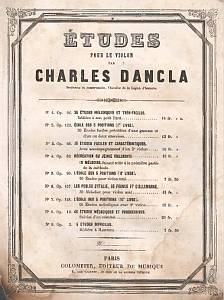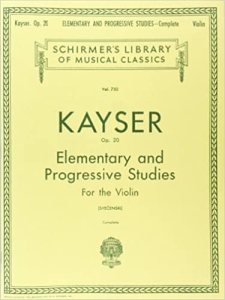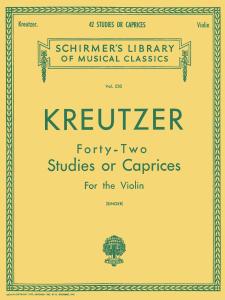There are many violin etudes, exercises that help a violin student progress. Here’s a list of almost all of them in order of difficulty:
- Egon Sassmannshaus – Early Start on the Violin
- Dancla – 36 Easiest Melodic Studies Op. 84
- Wohlfahrt – 60 Studies Op. 45
- Wohlfahrt – 40 Elementary Studies Op. 54
- Josephine Trott – Melodious Double-Stops
- Otakar Sevcik – School of Violin Technics
- Kayser – 36 Elementary and Progressive Studies Op.20
- Mazas – Études Spéciales Op. 36/1
- Kreutzer – 42 Études
- Schradieck – School of Violin Technique
- Galamian – Contemporary Violin Technique
- Fiorillo – 36 Études or Caprices
- Rode – 24 Caprices
- Dancla – Études Op. 73
- Gavinées – 24 Matinées
- DeBériot – Op. 123
- Dont – Études and Caprices Op. 35
- Wieniawski – École Moderne Op. 10
- Paganini – 24 Caprices
- Ernst – 6 Études à Plusieurs Parties
Note that some of them have several books which can span through several levels, like Sevcik and Sassmannshaus.
Of course, you don’t need to go through all of them as a student. Also, every teacher has some that they prefer or a combination of books. However, as you progress it helps to go back and either revisit or discover new etudes, especially if you’re interested in becoming a professional violin player.
The list of etudes is exceptionally long, so to make it easier for you to choose the right one, I added my recommendations below. But firstly, let’s have a look at what exactly is an etude and why it is important in your violin journey.
What is an Etude for Violin?
An etude is a composition, usually short, designed for practice to develop your technique. It’s what you would call an exercise, though etude is the proper term. It is a French word (étude) and translates as “study”. There are etudes for all instruments, the ones for violin are composed by well-known violinists and composers.
Usually, they are focusing on a specific technique, so if the etude is for practicing double stops, for example, you will encounter several examples of double stops in all strings and various positions. While there are exceptions, especially for advanced levels, they are usually monotonous and rarely sound like an actual musical piece.
The Importance of Etudes
You don’t have to play etudes to play the violin if you’re only interested in playing some easy songs you like. However, practicing etudes will really help you develop your technique. They are very important for any aspiring violinist and they really help. Sometimes they feel irritating, but you’ll see the benefits of studying them quickly.
Etudes contain similar motifs as the classic repertoire and are composed as a preparation for it. Only studying repertoire will be more difficult. Practicing them is also a fantastic way to stay in shape or use them as a warm-up. They can really help if you want to improve a specific technique and they are a great supplement to your practice. Any violinist who takes the craft seriously should practice etudes.
Violin Etudes for Beginners
Here is a short selection of etudes that I used to study myself. Especially for beginners I usually use the following books. I like to choose different etudes from several books depending on each student’s abilities.
Dancla: 36 Easiest Melodic Studies Op. 84

36 Easiest Melodic Studies Op. 84
by Dancla
An adorable collection with some very melodic etudes that can trick a beginner violinist into thinking they play actual musical pieces. I usually recommend this after the first year or so, because it needs some basic understanding of bowing techniques. Usually, before the etudes, there’s the relevant scale or preliminary exercises. Among the several violin techniques required, towards the end there’s even changing of positions.
Wohlfahrt 60 Studies Op. 45

Op. 45: Sixty Studies for the Violin – Book 1
by Wohlfahrt
Support us for more FREE content No extra costs for you Recommended by Violinists
This is one of the books everyone has played at least some etudes. They are very appropriate for a beginner and tackle a lot of techniques such as many types of bowing (détaché, marcato, staccato, etc.), trills, double stops, and more. Every different technique is introduced in a way that a beginner will understand and the difficulty level is progressing evenly so it feels easy going through it one by one.
Violin Etudes for Intermediates
The following three etudes are my recommendation for intermediate players.
Kayser 36 Elementary and Progressive Studies Op. 20

36 Violin Studies, Op. 20
by Heinrich Ernst Kayser
Not very melodic but a great tool to build a solid technique. Mostly use détaché or legato bowing but demand a reliable right hand. For some, this is considered a preparation for solo Bach.
Mazas Op. 36/1 Études Spéciales

Etudes, Op. 36 (book 1 & 2)
by Jacques Féréol Mazas
Usually, I give this along with Kayser and pick the most suitable from both. Mazas is more melodic and some of the etudes are beautiful to listen to, which is usually rare on that level. They are very stylish and need a lot of finesse.
Kreutzer 42 Études

42 Studies or Caprices
by Kreutzer
Support us for more FREE content No extra costs for you Recommended by Violinists
This is the violinists’ “bible”; it will be very hard to find a violin teacher who does not recommend it. Several different techniques are shown here in varying degrees of difficulty, a lot of double stops, and changing of positions. A book you’ll find yourself often returning to.
Violin Etudes for Advanced Violinists
Finally, my recommendations for advanced violinists.
Fiorillo 36 Études or Caprices

36 Études or Caprices by Fiorillo
One of the final etude books in the repertoire that sounds like one. While not essential they can be used as a preparation for Paganini, as well as the more advanced repertoire.
Dont Op. 35 Études and Caprices

Op. 35 Études and Caprices by Dont
These are advanced studies that require mastering all violin techniques so far. For some, this is one of the most difficult books on the violin, but someone who has mastered them can have no fear of conventional violin techniques.
Paganini 24 Caprices

24 Caprices by Paganini
The holy grail of every violinist! These are not really studies but rather use and expand all the violin techniques mastered so far, and a violinist must approach them as repertoire material rather than “exercises.” They are very difficult but genius. While not every violinist should try to master all of them, everyone should try at least a couple. After all, I’m sure you imagined playing some of the 24 caprices when you started studying the violin.
How do you practice an etude?
Etudes should never be approached without a bit of analysis and thinking. You need to understand what the etude is trying to show and how you can achieve it.
We always start slow at a tempo we feel comfortable with. Realize which technique is needed, if it’s not explained, and do some preliminary exercises if needed. When you have practiced enough, try to use different types of bowing (usually several variations are listed before the etude).
Final notes
By now you must know enough about etudes. Etudes are the easiest way to unlock the secrets of the violin technique, and as you see there are a lot of them. Even if you’re an advanced student you can always go back to the easier ones, you’ll see you’ll discover new things every time!
























